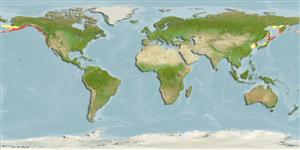>
Perciformes/Cottoidei (Sculpins) >
Cottidae (Sculpins)
Etymology: Leptocottus: Greek, leptos = thin + Greek, kottos = a fish (Ref. 45335); armatus: Leptocottus meaning slender Cottus; armatus armed, referrign to the sharp preopercular spines (Ref. 4930).
More on author: Girard.
Environment: milieu / climate zone / depth range / distribution range
Écologie
marin; saumâtre démersal; amphidrome (Ref. 51243); profondeur 0 - 156 m. Temperate; 60°N - 33°N
Eastern Pacific: Izembek Lagoon, on the southeastern Bering Sea coast of Alaska to Bahia San Quintin, northern Baja California, Mexico.
Taille / Poids / Âge
Maturity: Lm ? range ? - ? cm
Max length : 46.0 cm TL mâle / non sexé; (Ref. 2850); common length : 35.5 cm TL mâle / non sexé; (Ref. 12193); âge max. reporté: 10 années (Ref. 28936)
Épines dorsales (Total): 6 - 8; Rayons mous dorsaux (Total): 15-20; Épines anales 0; Rayons mous anaux: 15 - 20; Vertèbres: 37 - 39. Distinguished by the large upper preopercular spine ending in 3 or 4 sharp, upturned, curved spinules and by the large, dark spot on the posterior part of the spiny dorsal fin (Ref. 27547). Gill rakers reduced to flat, bony plates, each bearing a cluster of small teeth; lateral line nearly straight; each pore associated with a small subdermal cartilaginous plate (Ref. 27547). Caudal rounded (Ref. 6885). Grayish olive to rather green, occasionally with some yellow, dorsally; orange-yellow to white or silvery below lateral line; spiny dorsal dusky, with a black spot near tips of last 3 spines, a white band below it; soft dorsal fin dusky, with several oblique white to yellowish bands; pectorals yellow with 5 or 6 dark greenish bars; caudal dusky with one or two pale bands; anal and pelvic fins pale (Ref. 27547).
Commonly found near shore, especially in bays and estuaries; most frequently on sandy bottom (Ref. 2850). Intertidal individuals breath air when out of water (Ref. 31184). Can leave tide pools if aquatic conditions become inhospitable (Ref. 31184). Although some individuals may spend their entire life in highly saline waters (Ref. 28693), some newly metamorphosed young move from the estuarine spawning sites to completely fresh water and may remain there for up to 6 weeks (Ref. 27547). Adults apparently tend to remain in the shallow lower estuary, or farther offshore (Ref. 27547). Feeds mostly on crabs, shrimps and amphipods, but also takes larval, juvenile and adult fishes, as well as polychaete worms, mollusks and other invertebrates (Ref. 4930). Expands its gill covers and produces a low-pitched humming sound when stressed (Ref. 6885). Considered a nuisance by anglers (Ref. 27547).
Eschmeyer, W.N., E.S. Herald and H. Hammann, 1983. A field guide to Pacific coast fishes of North America. Boston (MA, USA): Houghton Mifflin Company. xii+336 p. (Ref. 2850)
Statut dans la liste rouge de l'IUCN (Ref. 130435)
Menace pour l'homme
Harmless
Utilisations par l'homme
Aquarium: Aquariums publics
Plus d'informations
RéférencesAquacultureProfil d'aquacultureSouchesGénétiqueElectrophoresesHéritabilitéPathologiesTraitementNutrientsMass conversion
Outils
Articles particuliers
Télécharger en XML
Sources Internet
Estimates based on models
Preferred temperature (Ref.
123201): 4.5 - 14.1, mean 8.7 °C (based on 352 cells).
Phylogenetic diversity index (Ref.
82804): PD
50 = 1.0000 [Uniqueness, from 0.5 = low to 2.0 = high].
Bayesian length-weight: a=0.01023 (0.00518 - 0.02023), b=3.19 (3.01 - 3.37), in cm total length, based on LWR estimates for this species & (Sub)family-body (Ref.
93245).
Niveau trophique (Ref.
69278): 3.7 ±0.64 se; based on food items.
Résilience (Ref.
120179): Milieu, temps minimum de doublement de population : 1,4 à 4,4 années (tm=1; tmax=10).
Fishing Vulnerability (Ref.
59153): Moderate vulnerability (36 of 100).
Nutrients (Ref.
124155): Calcium = 66.7 [29.5, 146.1] mg/100g; Iron = 0.418 [0.197, 0.881] mg/100g; Protein = 18.1 [16.0, 20.3] %; Omega3 = 0.668 [0.293, 1.935] g/100g; Selenium = 18.9 [8.9, 45.8] μg/100g; VitaminA = 8.11 [2.78, 24.42] μg/100g; Zinc = 0.618 [0.413, 1.057] mg/100g (wet weight);
